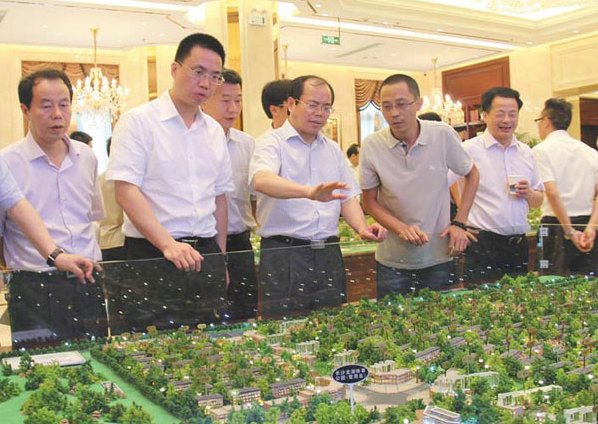Made a city district two years ago, a new Wangcheng emerges
|
Tan Xiaoping (third from left), Party chief of Wangcheng district, inspects a planning design. |
Once a county near Changsha, Wangcheng became the sixth district in the city two years ago and has been on a fast track to urbanization since.
With an emerging urban area, it also has many townships and villages with ancient architecture and scenic natural settings.
Tan Xiaoping, Party chief of the district, said that the local government plans to promote healthy development in both rural and urban areas.
Tan said the local government has implemented comprehensive measures to improve the environment. The district is more livable now and is lauded by the press as "a big park ".
One highlight in the urbanization of Wangcheng is that many of its townships and towns have established distinguished brand images in different areas, Tan said.
Jinggang town is known for its ancient buildings, while Qiaokou's main industry is fisheries and Tongguan is home to pottery. Xinkang has the tradition of Huagu opera and Chating is planted with sprawling flower fields.
Natural and cultural resources are the treasure of Wangcheng and have been protected strictly when the district government promotes urbanization, said Tan, adding that the authorities plan to build some influential tourism destinations.
Last year Wangcheng hosted the World Forum of Leisure Agriculture and Rural Tourism. It was also recommended as the permanent host of the forum.
Local farmers have enjoyed the benefits in urbanization in recent years, Tan said. The per capita net income of rural residents has increased significantly, he said.
He also noted that the local government has invested heavily in the construction of urban infrastructure in Wangcheng. The district has 35 construction projects underway this year at a total investment of nearly 400 million yuan ($65.3 million).
Tan said the local government plans to promote standardized infrastructure construction in its towns, including streets, kindergartens, public rest rooms, dump sites, food markets, nursing homes, clinics, parks and drinking water supply facilities.
Also, it will begin construction and renovation on 11 roads to narrow the transportation gap between urban and rural areas in the district.
Public services in education, medical treatment and social insurance have been gradually united in both urban and rural areas in recent years, Tan said.
In towns and villages, a number of cultural and sports venues have been built. Every town now has a sewage treatment plant and is connected to natural gas lines.
And every year a special fund invests 20 million yuan to support new startups and employment, said Tan.
Contact the writers at hantianyang@chinadaily.com.cn and fengzhiwei@chinadaily.com.cn



















